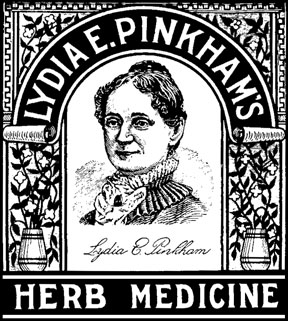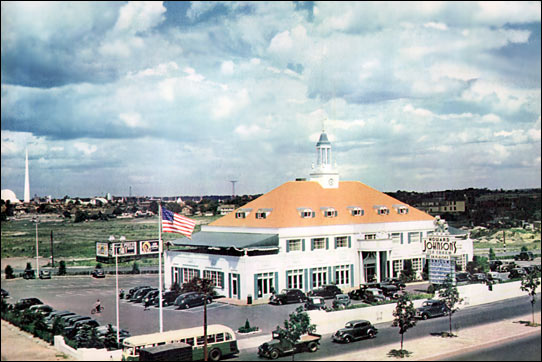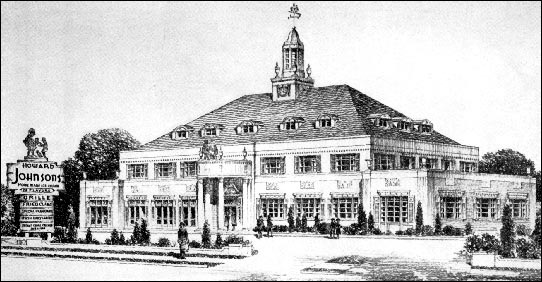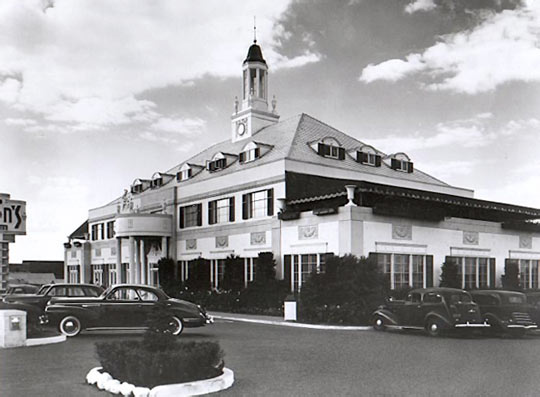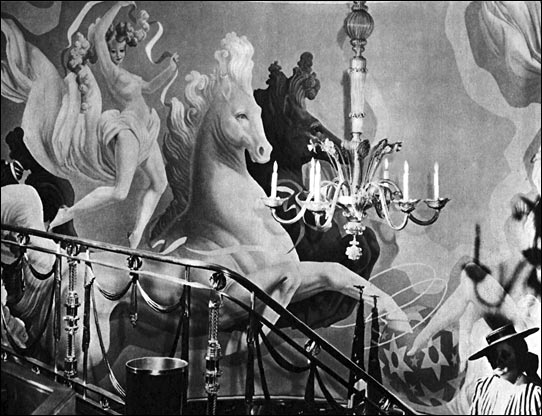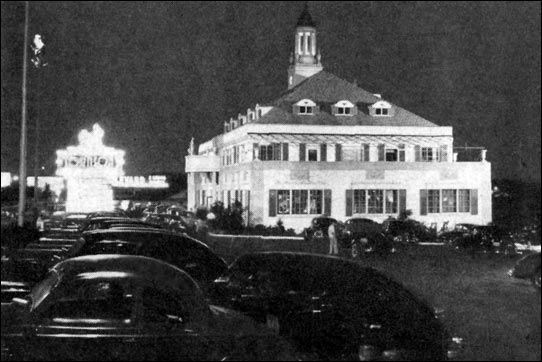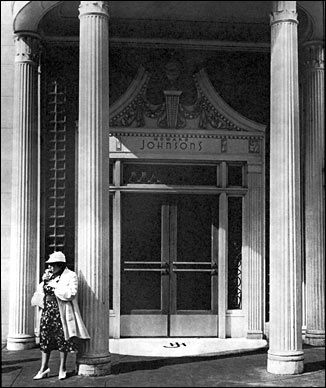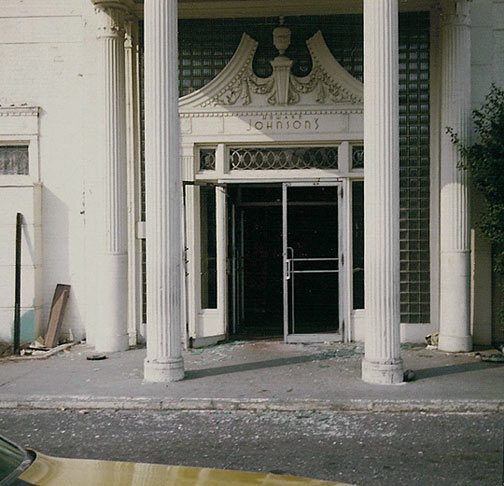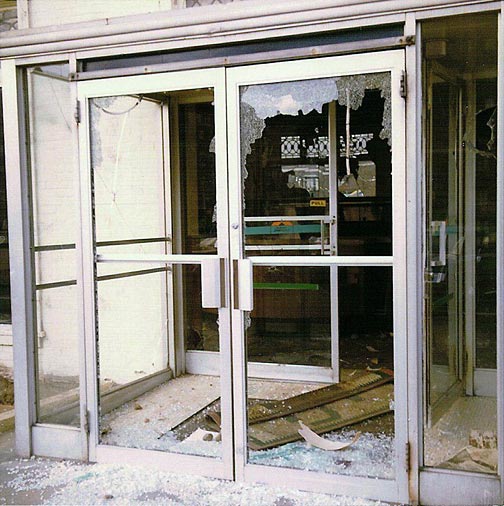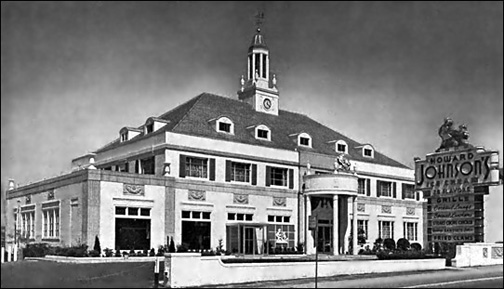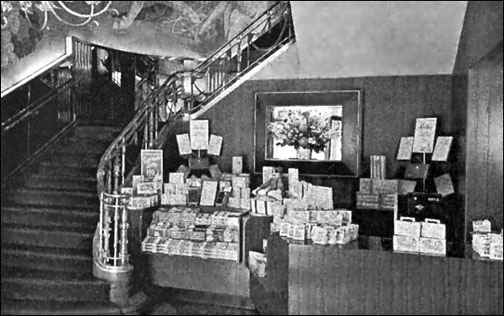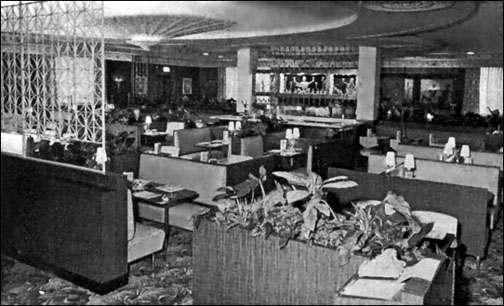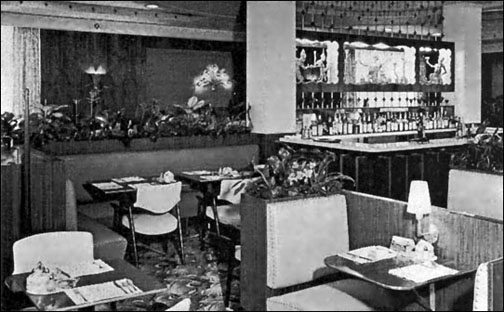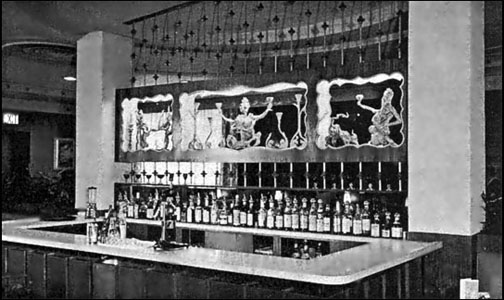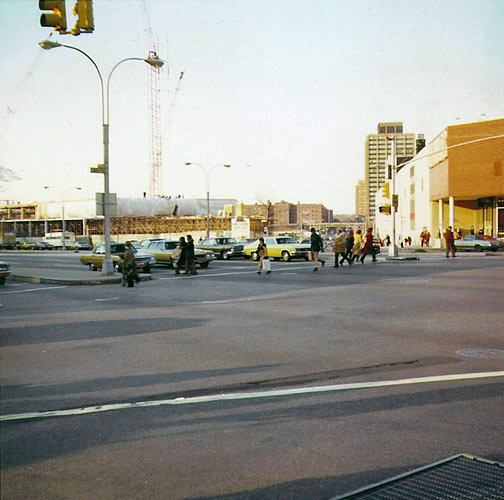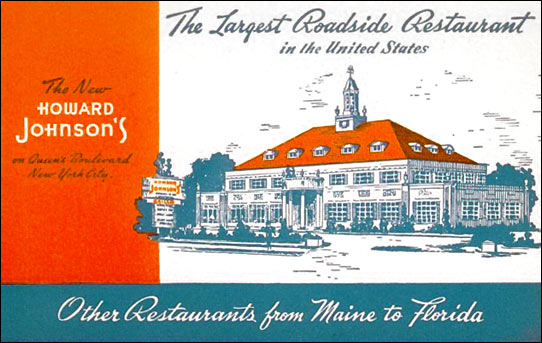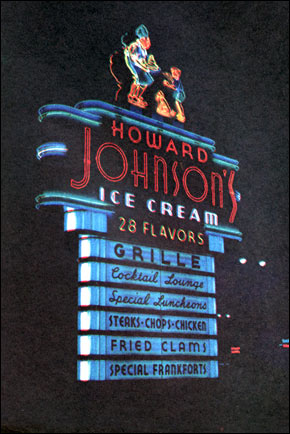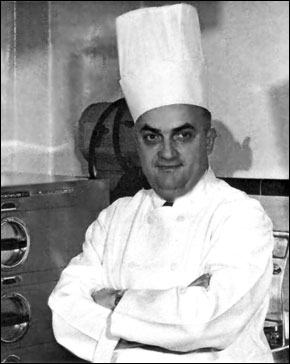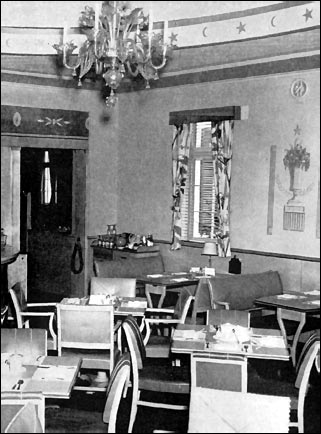| |
| Image
September 1940: Fortune |
|
Queens,
New York
AKA Rego Park |
| --
95-25 Queens Blvd @ Junction Blvd & 63rd |
| |
Touted as the largest roadside restaurant in the world and
built at a cost of $600,000.00 (the U.S. Bureau of Labor Statistics
CPI calculator indicates that amount to be more than $9 million
2009 dollars!), the colossal Queens restaurant was designed
by Howard Johnson's chief architect Joseph G. Morgan and was
erected by W. F. Babor & Co. Inc. An invitation only grand
opening dinner was held on January 17, 1940 which ushered
in Howard Johnson's short lived foray into the realm of near-luxury
dining.
The
Queens store was the second Howard Johnson's Restaurant financed
by Lydia Pinkham Gove (her first was along the Jericho Turnpike
on long Island outside of Garden City and opened in August
1938). Queens was managed by Jonco Inc., the Howard D. Johnson
Company's New York subsidiary. |
|
Apparently
no expense was spared even in the midst of the Great Depression,
and the Restaurant was awarded a bronze plaque for excellence
in design and construction of buildings erected in Queens Borough
during the year ending October 31, 1940 by the Queens Chamber
of Commerce.
|
At
least two New York Restaurants were financed by Lydia Pinkham Gove.
Miss Gove was heiress to a fortune created by her grandmother's
Lydia Pinkham's
Herb Medicine . .
Pinkham's
once well-known patent
medicine was concocted by Lydia
Pinkham
was concocted by Lydia
Pinkham in the 1870s. It was described as "a positive cure for all
those complaints and weaknesses so common to our best female population."
Following Pinkham's death in 1883, the company and its medicine
survived the scrutiny of the Pure
Food and Drug Act of 1906
in the 1870s. It was described as "a positive cure for all
those complaints and weaknesses so common to our best female population."
Following Pinkham's death in 1883, the company and its medicine
survived the scrutiny of the Pure
Food and Drug Act of 1906 ,
subsequent regulation, and a long simmering family feud. ,
subsequent regulation, and a long simmering family feud.
|
Miss
Gove has been described as an enterprising woman! In addition to
her role as treasurer of the Pinkham Medicine Company, and
financier of HoJo's, she was an aviator of sorts. In a history
making five day flight in August of 1926, Lydia Pinkham Gove
was the first person to fly in an airplane across North America
as a paying passenger.
has been described as an enterprising woman! In addition to
her role as treasurer of the Pinkham Medicine Company, and
financier of HoJo's, she was an aviator of sorts. In a history
making five day flight in August of 1926, Lydia Pinkham Gove
was the first person to fly in an airplane across North America
as a paying passenger.
Moreover, in 1935 with money as no object during the Great
Depression, she built a "home" modeled from Carcassonne
Castle at a cost of $500,000 (nearly $8 million in 2009 dollars!!).
She named the edifice, "Sky High." With irony, Gove
died on February 24, 1948 from complications of ovarian cancer.
Her friend, Howard D. Johnson, donated $5,000.00 (about $45K
in 2009 dollars) to the Runyon
Fund
at a cost of $500,000 (nearly $8 million in 2009 dollars!!).
She named the edifice, "Sky High." With irony, Gove
died on February 24, 1948 from complications of ovarian cancer.
Her friend, Howard D. Johnson, donated $5,000.00 (about $45K
in 2009 dollars) to the Runyon
Fund in her memory.
in her memory. |
|
|
|
| |
| Image
September 1940: Fortune |
|
| |
"The
Largest Roadside Restaurant in the World. Masterpiece
of restaurants opened in 1940 on Queens Boulevard in the Forest
Hills section of New York City, just outside the World's
Fair park. Three stories in height and built at a cost of
$600,000, this building boasts its own bakery and two complete
kitchens. Seating capacity in winter is about 700. In summer
two awninged terraces on the second floor, furnished in cool
wicker and pastel cushions, invite 300 more guests to linger
over a frosty drink.
The
three dining rooms are so restfull and so attractive that
at first we miss some of the details which go to make their
perfection ... the thick soft carpets ... the glittering chandeliers
... the blue green Venetian blinds, the maroon leather upholstery
... the restrained use of color in walls and draperies ...
the charm of a light-fountain playing in the Empire Room.
Across
the hall from the Empire Room upstairs is the Colonial Room.
Both are available for private parties, weddings, Communion
breakfasts, bridge parties, and other social gatherings. The
kitchens are marvels of efficiency. Everything moves like
clockwork. Four thousand dinners are served on Sunday with
less fuss then you or I would entertain our in-laws. When
you're in New York, don't fail to eat at "Queens"
. Tell your friends about it. It isn't just another restaurant.
It's a Waldorf Astoria of a place! It's a dream come gloriously
true!" |
|
Freezer
to Fortune; The Amazing Story of Howard Johnson 1941 |
|
|
| |
| |
| Image:
From Freezer to Fortune; The Amazing Story of Howard Johnson
1941 |
|
| |
| |
|
| |
| |
| |
Video*
1939: To New Horizons
Produced by Handy (Jam) Organization & Sponsored by General
Motors Corporation, Dept. of Public Relations
http://www.archive.org/details/ToNewHor1940
 (Prelinger
Archives) (Prelinger
Archives)
Caption:
"Definitive document of pre-World War II futuristic utopian
thinking, as envisioned by General Motors. Documents the Futurama
exhibit in GM's Highways and Horizons pavilion at the World's Fair,
which looks ahead to the wonder world of 1960." |
| |
|
The
United States had been mired in Depression for some ten grueling
years and worse, the Winds of War were blowing from across the seas.
The nation needed a distraction which fore-glimpsed better days
ahead. New York's 1939-'40 World's Fair was the ticket! The Fair
ran from April 30, 1939 to October 27, 1940, and was a showcase
of progressive, prosperous modernity with corporations and nations
producing exhibits of fancy. Visitors of the spectacle were witness
to the "Dawn of a New Day", and could see for themselves
"the world of tomorrow." Given a time machine, the 1939-'40
New York World's Fair will be a stop for me;)
Realizing
the potential for his Restaurant business, Howard D. Johnson welcomed
and encouraged financiers like Miss Gove to assist him in expanding
his empire in and around New York City in order to take advantage
of the throngs of tourists "going to the fair, or anywhere!"
Although the Queens HoJo's did not have the entire run of the Fair
since it opened in 1940, it nonetheless attracted many fair goers
and reportedly enjoyed immediate successful operation.
As
for the Fair, when it closed those among the European entourage
were unable to return home due to the onset of WW II. Thus even
after the War many remained in the United States and exercised considerable
influence on American culture. |
| Howard
Johnson Landmark: June-July 1960 |
|
One example is Pierre
Franey who had been Poissonneur (a specialist in seafoods) at the French
Pavillon working for Henry Soulé. After the Fair, Soulé
opened his famed Le Pavillon (a restaurant both Johnson's frequented)
where Freney was recruited and remained from 1946 until 1960.
When Soulé and Franey had a falling out in 1960, Chef Franey
was hired by Howard D. Johnson. That a renowned chef would work
for the Howard Johnson's chain was considered scandalous at the
time!
who had been Poissonneur (a specialist in seafoods) at the French
Pavillon working for Henry Soulé. After the Fair, Soulé
opened his famed Le Pavillon (a restaurant both Johnson's frequented)
where Freney was recruited and remained from 1946 until 1960.
When Soulé and Franey had a falling out in 1960, Chef Franey
was hired by Howard D. Johnson. That a renowned chef would work
for the Howard Johnson's chain was considered scandalous at the
time!
Chef
Franey (who's wife had been a Howard Johnson's hostess during
her pre-matrimony) was instrumental in creating and adapting many
food specialties for use in the Howard Johnson Company's then
growing commissary system. Thus he significantly expanded Americans
culinary experiences and expectations.
|
|
| |
|
|
| |
|
| |
| |
| Photograph
ca. 1940s: Unknown source |
|
| |
| |
| Image
September 1940: Fortune |
|
| |
The Queens colossus was the culmination of Howard Johnson's
development from simple beachside stand into the ultimate
in dining experience. Described as Colonial architecture,
the monument to dining was decorated with Venetian blinds,
crystal chandeliers made to order in Italy, elaborate
murals, and exuded an overall expansive and impressive
atmosphere of luxury.
Moreover,
the palatial thousand seat restaurant's main entryway
was under a white-pillared portico which led into an elliptical
hall of noble proportions. Within that entry hall was
a wide grand stairway which wound gracefully upward toward
a great rose and gold crystal chandelier, and along the
walls were striking murals painted by the celebrated colorist,
Andre
Durenceau . .
Like
the progress promised by the much celebrated World's Fair,
the Queens HoJo's pointed to a future that was not quite
to be.
|
|
Photo:
From Freezer to Fortune;
The Amazing Story of Howard Johnson 1941 |
|
Business Week reported on June 19, 1943 that war-time gasoline
rationing had taken its toll on Howard Johnson--Queens was among
the three quarters of Howard Johnson's Restaurants shuttered for
the duration of the War. After the War Johnson decreed that there
would be no more roadside cathedrals. Following the 20th century's
greatest conflagration, Johnson completely refocused his orange
roofed chain away from any pretense at luxury--its purpose would
be to serve the burgeoning and increasingly mobile middle class
of Americans providing them with an unprecedented standardized
product and quality of service! |
|
| |
| Image:
Life Magazine September 6, 1948 |
|
| |
| |
| Image
September 1940: Fortune |
|
| |
| |
| Photographs
March 1974: Jeffrey Morris |
| |
Above,
Below & Lower: Jeffrey Morris while out for a walk
in March of 1974 found the Queens Restaurant in a sorry state
and noted; "I was shocked to discover that the place was
closed, and apparently in the process of being demolished -- although
they had not yet even put up a construction fence around it. I
quickly ran home for my camera. As a result I was able to get
these relatively close shots of the building."
His
recollection was that "at the time, I assumed they were simply
renovating the place, because it seemed incomprehensible to me
that it would be torn down. But it was very strange and confusing;
things didn't look quite "right" and when I looked closer
I saw the broken glass. There were no signs, no fences, nothing
to indicate there was anything out of the ordinary going on except
that there were mostly station wagons [the pickup trucks &
SUVs of that past time] in the parking lot."
|
|
| |
| |
Above
& Below: A Secondary entrance was added to facilitate
easier access to the dairy bar. The Restaurant was remodeled and
modernized in 1959 with a Simple Simon and the Pieman and name
banner added to the secondary entrance's right. Note the post
1967 roof logo decal on the door and the older 'H' in the 'J'
door mats amidst the broken shards of glass... |
|
| |
| Images:
Howard Johnson's Landmark: Sept-Oct, 1959 |
|
| |
| |
|
| |
| |
|
| |
| |
|
| |
The
"Queen" of the chain
Queens Boulevard, L. I., New York |
Twenty years ago, many of the millions of people who
came from the far corners of the nation to visit the 1940
WORLD's FAIR the guests of our young and
stately "Queen" who had come to reign on the Boulevard
in 1939. Billy Rose's original Aquacade, a neighbor to her
majesty, was a popular and famous entertainment spot. The
celebrities of this water spectacular were frequent guests
of our reigning beauty. Indeed, she was a regal sight as
one drove along a then sparsely settled Queens Boulevard.
Years
of successful service took their toll -- her regal robes
had lost some of their dignity, the ermine that once trimmed
her velvet cloak had shed it's lustrous fur. TIME
TO REFURBISH. TIME TO UPLIFT.
Mr.
Joseph Cicco, Chief Architect, redesigned a complete new
wardrobe for our "Queen" -- the modern look. As
the pictures indicate, elegant furnishings were selected,
modern equipment installed -- including the new Admanation
dishwashing machine which in this unit handles an extremely
high volume of business; competent personnel, as loyal subjects
to our "Queen" are stationed in every department.
With confidence, she reopened her doors and once again towers
over all she surveys along the completely built up "Boulevard
of Profits" . Her majesty the "Queen" reports
--"sales ahead by 30% over last year's figures."
|
|
Howard
Johnson's Landmark: Sept-Oct, 1959 |
|
|
| |
|
| |
| |
|
| |
| |
|
| |
| |
| Image: Architectural
Record; March 1960 p.142 |
|
| |
| |
| Photographs
March 1974: Jeffrey Morris |
| |
Above:
Mr. Morris said, "Note the "Open for Breakfast"
sign... unfortunately, it was just plain open to the elements
soon after this." And demolished shortly thereafter. |
|
| |
|
| |
| |
|
| |
| |
| Photograph
26 December 1974: Jeffrey Morris |
| |
Jeffrey
Morris further reported that, "By December of 1974, there
was an office building under construction on the site. (That's
Queens Blvd. people are crossing in the foreground, and Alexander's
Department Store's red brick facade on the right. After Alexander's
went out of business, it became a Caldor, minus the distinctive
brick. After Caldor went out of business, it was split up into
a number of other chain stores.) The overpass you can just make
over Junction Blvd. in the distance is the Long Island Expressway."
|
|
| |
| Image
ca. 2005: Google Street View |
|
| |
| |
|
| |
| |
| Postcard
ca. 1940s: Nate Coggeshall-Beyea |
|
| |
|
The
purpose of this site is informational. It is neither commercial
nor representative of any brand, company, or business. Trade names,
trademarks, etc. that are depicted remain the property of their
respective owners. Please contact this site's owner
prior to reproducing any part of it. Works from contributors (includes
photographs, ephemera, etc.) must not be reproduced without their
explicit consent. |
|
*Embedded
media is not owned or hosted by the owner of this site. Please note
that if the IP address of an embedded item is changed (or deleted)
it can no longer be viewed through this page. |
|
